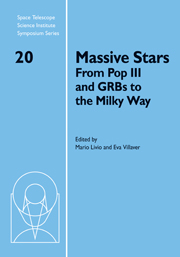Book contents
- Frontmatter
- Contents
- Participants
- Preface
- High-mass star formation by gravitational collapse of massive cores
- Observations of massive-star formation
- Massive-star formation in the Galactic center
- An x-ray tour of massive-star-forming regions with Chandra
- Massive stars: Feedback effects in the local universe
- The initial mass function in clusters
- Massive stars and star clusters in the Antennae galaxies
- On the binarity of Eta Carinae
- Parameters and winds of hot massive stars
- Unraveling the Galaxy to find the first stars
- Optically observable zero-age main-sequence O stars
- Metallicity-dependent Wolf-Rayet winds
- Eruptive mass loss in very massive stars and Population III stars
- From progenitor to afterlife
- Pair-production supernovae: Theory and observation
- Cosmic infrared background and Population III: An overview
Eruptive mass loss in very massive stars and Population III stars
Published online by Cambridge University Press: 04 August 2010
- Frontmatter
- Contents
- Participants
- Preface
- High-mass star formation by gravitational collapse of massive cores
- Observations of massive-star formation
- Massive-star formation in the Galactic center
- An x-ray tour of massive-star-forming regions with Chandra
- Massive stars: Feedback effects in the local universe
- The initial mass function in clusters
- Massive stars and star clusters in the Antennae galaxies
- On the binarity of Eta Carinae
- Parameters and winds of hot massive stars
- Unraveling the Galaxy to find the first stars
- Optically observable zero-age main-sequence O stars
- Metallicity-dependent Wolf-Rayet winds
- Eruptive mass loss in very massive stars and Population III stars
- From progenitor to afterlife
- Pair-production supernovae: Theory and observation
- Cosmic infrared background and Population III: An overview
Summary
I discuss the role played by short-duration eruptive mass loss in the evolution of very massive stars. Giant eruptions of Luminous Blue Variables (LBVs) like the 19th century event of η Carinae can remove large quantities of mass almost instantaneously, making them significant in stellar evolution. They can potentially remove much more mass from the star than line-driven winds, especially if stellar winds are highly clumped such that previous estimates of O-star mass-loss rates need to be revised downward. When seen in other galaxies as “supernova impostors,” these LBV eruptions typically last for less than a decade, and they can remove of order 10 M⊙ as indicated by massive nebulae around LBVs. Such extreme mass-loss rates cannot be driven by radiation pressure on spectral lines, because the lines will completely saturate during the events. Instead, these outbursts must either be continuum-driven super-Eddington winds or outright hydrodynamic explosions, both of which are insensitive to metallicity. As such, this eruptive mode of mass loss could also play a pivotal role in the evolution and ultimate fate of massive metal-poor stars in the early universe. If they occur in these Population III stars, such eruptions would also profoundly affect the chemical yield and types of remnants from early supernovae and hypernovae thought to be the origin of long gamma-ray bursts.
- Type
- Chapter
- Information
- Massive StarsFrom Pop III and GRBs to the Milky Way, pp. 187 - 198Publisher: Cambridge University PressPrint publication year: 2009

